Volvo S60 T5 upgrade deserves a medal
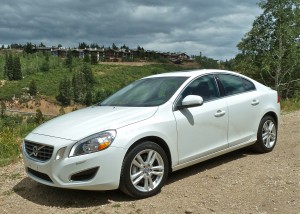
Volvo S60 T5 adds all-wheel drive for 2013, the easier to reach Utah's Stein Eriksen Lodge, in the background.
By John Gilbert
PARK CITY, Utah — Returning to the driver’s seat of a Volvo S60, and returning to Utah’s mountainous ski country were similarly familiar, particularly when both circumstances coincided with the late-July opening of the 2012 Olympics.
True, the 30th Summer Olympics — or the XXX Games, for those who prefer their competition X-rated — were starting in London, but the Winter Olympics were held in Salt Lake City in 2002 and remain riveted in memory because. I worked for the Olympic Committee at Salt Lake City, as supervisor of all the hockey information dispersed over the intranet service for the assembled hundreds of media from around the world. My wife, Joan, was a member of my six-person staff, and we worked tirelessly to produce swift and accurate news reports, even in the face of constant pressure by a National Hockey League official determined to turn the the Olympics into an NHL PR-event.
That’s another story. But when Volvo decided to introduce the final version of the popular S60 midsize sedan at Park City, where some of the 2002 ski events were conducted, it was a cinch, and it became a unique event when Volvo also asked auto-media types to bring along a spouse or other guest. The car as mainstream family vehicle was the obvious focal point, but we also were given the opportunity to visit Utah Olympic Park, to watch a unique presentation by the Flying Ace All-Stars, a group of past, present and future Olympic and world extreme ski-jumpers, and even to examine the bobsled, luge and ski jumping courses. Later we rode the Xtreme Zipline — the fastest way down from the mountaintop.
The S60 is Volvo’s mainstream staple, and between 2010 and 2012, Volvo has offered it as a high-performance turbocharged 6-cylinder, all-wheel-drive sporty vehicle, and as a more docile 5-cylinder, front-wheel-drive car.
Logic, and marketing pressure, left a large opening between those two extremes, and that is what Volvo is filling for 2013, upgrading the base 5-cylinder to a turbo all-wheel-drive model that covers the best of both worlds — performance and fuel-efficiency — while adding the all-wheel drive feature that now separates all-weather superstars from marginalized competitors.
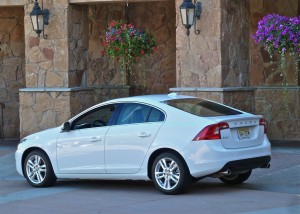
Forget the image of boxy Volvos; the new S60 T5 AWD is even at home as a Swedish car at a Norwegian's resort.
Our first impression was how free of wind or tire noise the car is, so S60 fans needn’t be concerned. But with the new model, you could say FWD might win the bronze, or even the silver, but it will take AWD to win the gold in areas where foul-weather driving is common.
First introduced as a 2001 model, the S60 was positioned between the larger luxury S80 and the more compact S40. A solid and steadfast all-season car with traditional Volvo safety benefits, and the most comfortably supportive seats in the industry, the S60 did right well in sales. A couple years later, Volvo added the S60-R, which transformed a nice family sedan into a turbocharged, all-wheel-drive, high-performance hot rod. Despite the obvious resemblance to a boxier heritage, it was my favorite Volvo ever.
After the normal five- or six-year plan for the redesigning, Volvo ran into an economic roadblock. It was 2007, and the bottom was falling out of the car market along with the rest of the economy. Ford, which owned Volvo at the time, convinced its Swedish affiliate to hold back on building the new S60 because of costs. Ford’s foresight helped it avoid bankruptcy bailouts that its top competitors, General Motors and Chrysler Corporation, required to remain in business. Ford later sold Volvo, Jaguar, Land Rover, and its majority share in Mazda. All are currently succeeding in the world marketplace.
Volvo is now owned by the Zhe-Zhiang holding company of China, which also owns Geely, a Chinese auto-maker. Volvo, which never compromised on making arguably the safest fleet of vehicles on the planet, moved onward and upward with the infusion of new money from a nation that has become the top automotive market in the world, as well as the manufacturer of current U.S. Olympic uniforms. Among the first orders of business was introducing the second generation S60, which hit the streets in 2010 as a stylish departure from the previous boxiness of Volvos. No more boxy corners, replaced by stylish and aerodynamic slopes and contours.
Surprisingly, Volvo surprised the auto world by introducing the S60 as an all-wheel-drive turbo 6-cylinder in 2010, with over 300 horsepower and torque figures, possibly as a determined effort to show that things were going to be different in Gothenberg. It wasn’t until six months later that Volvo followed with its high-volume, mainstream version of the car, with a 5-cylinder engine and only front-wheel-drive, with a lower price and better fuel economy. Earlier this year, Volvo expanded the input of Polestar, its high-performance electronic tuning affiliate, and created an even-more potent S60 T6.
That still left room for one more model — the T5. Turbocharging the 5-cylinder increases its power to 250 horsepower and 256 foot-pounds of torque, important to aid with the added all-wheel drive.
All-wheel drive is a deal-breaker in the heavy-snow regions of Minnesota, New England, Michigan, Illinois, Wisconsin, North and South Dakota, Montana, Wyoming, Idaho, Nebraska, Colorado and, yes, Utah. Proper winter tires on a good FWD car can do an effective job in winter driving, but the Audi A4 quattro, BMW 328iX, Mercedes C300 FourMatic, Infiniti G25X and Lexus IS-250 — all feature all-wheel drive. While Volvo’s S60 T6 AWD is more expensive, the S60 T5 without AWD was missing some mainstream sales.
Volvo markets itself to “premium intenders” — those moving up from mainstream cars to premium vehicles — so providing the new S60 T5 with all-wheel drive brings those sporty-sedan competitors into reach.
The impressive new Haldex system, also used in the T6, is calibrated to improve cornering and handling by all four wheels, as well as foul-weather performance. Smaller and lighter, the Haldex system reads and adjusts the torque distribution needs front and rear in 100 milliseconds, on a constantly variable system. When cruising routinely at 60 mph or more, the car runs with 95 percent of its torque going to the front axle, for the sake of fuel efficiency.
Any tendency to slip immediately signals adjustment of up to a 50-50 split of torque to front and rear. Also, during takeoff, when there is a normal weight shift from front to rear, torque is distributed 50-50, assuring equal power to all four wheels for a more secure start.
Our first impression driving the S60 T5 AWD was how free of wind or tire noise it is. A close second impression was mine alone. With the less-powerful 5 attempting to do the work that I’ve experienced with the T6, I anticipated a drop in performance feel, but I was wrong. The lighter T5 with FWD goes from 0-60 in a sporty 6.4 seconds, and the T5 AWD does it in 6.6 seconds, a difference that is imperceptible.
Joan, said she found herself driving faster than she thought a few times, and I couldn’t disagree. Once I pulled out to pass a slow-moving truck, darting by as quickly as possible when the dotted center line interrupted the solid stripe, and at a glance I noted the speedometer had surged to 100 mph.
The most impressive feature is its unique overboost feature. Turbo boost is increased electronically to raise torque from 256 to 295 foot-pounds at each shift-point, second through sixth. Whenever you’re driving aggressively, the extra torque makes the T5 feel much more powerful than any 2.5-liter engine should.
Sport mode complements the system perfectly. Clicking the shift lever to the left engages Sport, which changes the shifting and throttle algorithms, making upshifts two-tenths of a second quicker.
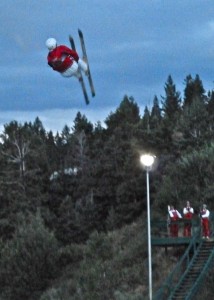
Olympic hopefuls train year-round, as Flying Ace ski acrobat somersaulted off an artificially coated ski jump.
Volvo also installed torque-vectoring on the S60 T5 AWD, a system that can fool any driver into believing he or she is better than they might be. In hard cornering maneuvers, that computer control gently applies brake force to the inside wheels, causing a corresponding increase in the amount torque being sent to the outside wheels. The result is the car turns more sharply, for quicker and more precise cornering. The torque boost occurs even when you leave the transmission in Drive, but by switching to Sport mode, you can also downshift manually with the shift lever.
I would like to have steering-wheel paddles to do the same thing, and Volvo officials say they’re working on that feature.
To handle the extra power, Volvo’s engineers revised the new 5-cylinder engine to add a new crankshaft, and new pistons and piston rings, while also reducing internal friction, and increasing the compression ratio. Still, the stronger-performing AWD T5 shows an EPA-estimated 29 miles per gallon in highway driving. We got about 24 mpg when I ran the car hard, through the twistiest Utah mountain roads, manually selecting third or fourth gear. No matter how hard you wanted to push it, the car cornered with smooth precision.
The S60 T5 has a base price of $32,550, increasing to $34,550 with all-wheel drive. The well-equipped base car sticker can escalate rapidly if you choose such features as the Premier trim level — leather seats, a sunroof, and climate control — which fetches a sticker over $38,000.
Those prices fit in near or under the target AWD cars. Volvo says it is right between the premium and mainstream segments, gaining 20 percent of customers from the premium side, and 80 percent of its conquests from those moving up from mainstream toward premium vehicles.
The test car’s premium side with added potency was ideally suited to confront the mountain roads we drove, from just west of Salt Lake City and onto a 210-mile loop that swung north into Wyoming before circling back.
That “Midsommar Drive” was the work part of the introduction, but we were always reminded of the Olympic undercurrents, residing in the nation’s most popular ski resort region of Park City, and being housed at the Stein Eriksen Lodge. Named after former Olympic ski-racer Stein Erickson, who won the 1952 Gold Medal in his beloved homeland at the Oslo Winter Olympics, Eriksen later won multiple slalom World Championships. Living and skiing in the Deer Valley resort area, Eriksen thought it would be convenient if he could ski down from Bald Mountain and have a neat resort awaiting at the bottom, so Stein Eriksen Lodge was built. Even at his advancing age, Eriksen continues to visit the place and sometimes might do a little downhill skiing.
We rode the chairlift up from Stein Eriksen Lodge’s 8,100-foot elevation to the 9,400-foot peak of Bald Mountain, then hiked back down, over two hours down rocks and through meadows.
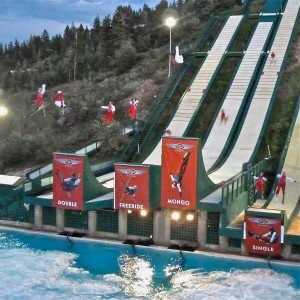
Closing the Flying Ace show at Olpympic Park, all the jumpers performed simultaneous specialties into the pool.
Utah Olympic Park, located between Park City and Interstate 80, where skiers can train on specially covered surfaces year-round. The Flying Ace All-Stars, a group of a dozen former, current and future freestyle jumpers, put on a show skiing down five adjacent ski jumps and flying off into space to execute multiple twists and somersaults, before landing in a special water-filled pool.
We also tried Xtreme Zipline, taking a chair lift to the top of the park, then being buckled into an individual seat and parachute-like harness, attached to an overhead steel cable. The 70-mph run down to the bottom was swift, and had to be what parachuting is like. It was a blast, although I prefer being in complete control — which we experienced back on the highway, inside the Volvo S60 T5 AWD.
Back at the Stein Eriksen Lodge, and meeting the gracious ambassador from the Swedish consulate, it occurred to me that despite all the good-natured heckling that goes on between the Swedes and Norwegians, they actually can get along quite well. The Norwegians can keep producing world-class Olympic skiers and build resorts named after them, and the Swedes can keep on making impressive motor cars that can reach any mountain resort in style.
Comments
Tell me what you're thinking...
and oh, if you want a pic to show with your comment, go get a gravatar!


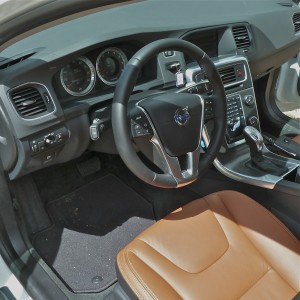
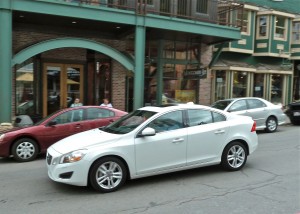
 John Gilbert is a lifetime Minnesotan and career journalist, specializing in cars and sports during and since spending 30 years at the Minneapolis Tribune, now the Star Tribune. More recently, he has continued translating the high-tech world of autos and sharing his passionate insights as a freelance writer/photographer/broadcaster. A member of the prestigious North American Car and Truck of the Year jury since 1993. John can be heard Monday-Friday from 9-11am on 610 KDAL(www.kdal610.com) on the "John Gilbert Show," and writes a column in the Duluth Reader.
John Gilbert is a lifetime Minnesotan and career journalist, specializing in cars and sports during and since spending 30 years at the Minneapolis Tribune, now the Star Tribune. More recently, he has continued translating the high-tech world of autos and sharing his passionate insights as a freelance writer/photographer/broadcaster. A member of the prestigious North American Car and Truck of the Year jury since 1993. John can be heard Monday-Friday from 9-11am on 610 KDAL(www.kdal610.com) on the "John Gilbert Show," and writes a column in the Duluth Reader.